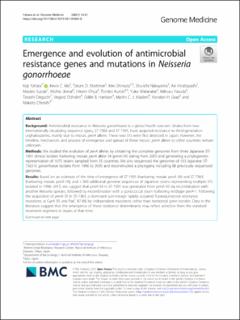| dc.description.abstract | Background: Antimicrobial resistance in Neisseria gonorrhoeae is a global health concern. Strains from two internationally circulating sequence types, ST-7363 and ST-1901, have acquired resistance to third-generation cephalosporins, mainly due to mosaic penA alleles. These two STs were first detected in Japan; however, the timeline, mechanism, and process of emergence and spread of these mosaic penA alleles to other countries remain unknown. Methods: We studied the evolution of penA alleles by obtaining the complete genomes from three Japanese ST-1901 clinical isolates harboring mosaic penA allele 34 (penA-34) dating from 2005 and generating a phylogenetic representation of 1075 strains sampled from 35 countries. We also sequenced the genomes of 103 Japanese ST-7363N. gonorrhoeae isolates from 1996 to 2005 and reconstructed a phylogeny including 88 previously sequenced genomes. Results: Based on an estimate of the time-of-emergence of ST-1901 (harboring mosaicpenA-34) and ST-7363(harboring mosaicpenA-10), and >300 additional genome sequences of Japanese strains representing multiple STs isolated in 1996–2015, we suggest that penA-34 in ST-1901 was generated from penA-10 via recombination with another Neisseriaspecies, followed by recombination with a gonococcal strain harboring wildtype penA-1. Following the acquisition of penA-10 in ST-7363, a dominant sub-lineage rapidly acquired fluoroquinolone resistance mutations at GyrA 95 and ParC 87-88, by independent mutations rather than horizontal gene transfer. Data in the literature suggest that the emergence of these resistance determinants may reflect selection from the standard treatment regimens in Japan at that time. Conclusions: Our findings highlight how antibiotic use and recombination across and withinNeisseriaspeciesintersect in driving the emergence and spread of drug-resistant gonorrhea. Keywords: Recombination, Horizontal gene transfer, Genomic epidemiology, Antimicrobial resistance, Phylogeny,Surveillance, Evolution,Neisseria gonorrhoeae | |
